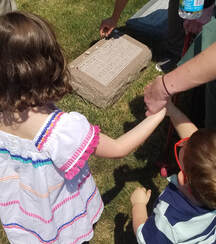weekly column
|
Each week, find a commentary on something connected to verses of Torah or another source of wisdom
|
|
Each week, find a commentary on something connected to verses of Torah or another source of wisdom
|
 The Numbers:13 Project he stood between the dead and the living until the plague was checked. Numbers 17:13 It took a long time for me to demystify visiting a cemetery. I never considered it “creepy” to be present among the graves and their markers. In fact, even before I studied to be a rabbi (when I began visiting cemeteries for professional reasons), I was fascinated by the personal histories represented by the tombstones. The information on them was enlightening about the life of the individual and the family left behind. The material from which they were carved reflected not only aesthetic choices but implied a socio-economic status. The shape and size could convey details too painful to memorialize in words; a marker carved like a lopped tree trunk was a sure sign of a healthy young person lost in the prime of life. The part that was difficult for me was walking among the graves. Perhaps due to idioms like “dancing on his grave” or “desecrating her grave” I found myself walking in unnatural ninety-degree patterns while muttering small apologies for a misstep as if stepping over the unidentifiable end of the actual grave was a sort of injury to the deceased. And attempts to read the fading letters or view the embedded photos on some gravestones resulted in twisting my posture in ways I can no longer confidently attempt. Of course, a burial ceremony almost always requires that people stand and walk on the graves of others. And it slowly dawned on me that it was not merely “sacred purpose” that excused a step on a grave. The earth that blankets the dead is the barrier between the dead and the living. This phrase from the Bible has always intrigued me. It is as blatant in Hebrew as it is in English – as if Aaron (the “he” in the verse) were positioned between two similar cohorts of people, one the living and the other zombies, walking dead, attacking hordes. It’s the word “until” that brings it out, because it implies the process of death from the plague did not end with Aaron assuming his sentry position. As it happens, I was thinking about what I would write about this verse during the weeks on either side of a family gathering organized by my sister. This winter, it will be my father’s thirtieth yartzheit, the thirtieth anniversary of his death. Chicago is very cold in the winter; indeed, my father’s burial took place on a day of record-setting temperatures. So, at my sister’s suggestion, we scheduled an observance at his grave on a warm day. She arranged for the military honors we did not have at his burial, and each of his children took the opportunity to speak. My dad is buried with his parents and in close proximity to many of his aunts, uncles and cousins. Before us as we spoke was family – my mom, his children and most of their spouses, most of his grandchildren, many of his nieces and nephews and half of his six great-grandchildren. We called on his presence in remembrances and in his own words, written as a soldier during his service in the Second World War. We stood between the dead and the living, until. There was no plague to arrest. But there was good reason for the living to stand before the dead until it was time to take our leave and return to the house in which the three of us were raised. We went there to do the things we do only when we are alive: to eat, to tell stories, to laugh, to remember and to plant the seeds of memory for the youngest who were there. I remain mystified by the tableau that the Bible describes. Despite numerous attempts by commentators to explain it, the plain meaning is hard to understand. But I now have a clearer understanding of what I have done for many, many people during my years as a rabbi, at funerals and memorial services and ceremonies to dedicate the tombstones. I stood between the dead and the living until the immediacy of the grief had been checked. By my willingness to stand in that breach, I assured them that a loved one’s death was not contagious, and that just as they assembled “until” for this person, others would assemble “until” for them.
0 Comments
Leave a Reply. |
Archives
October 2023
Categories |